Mon 24 January 2022:
Oil is a red-hot commodity right now, and a slew of factors are converging that could send prices even higher.
Oil has been on a steady climb in recent weeks – reaching its highest level since 2014 on Wednesday – and analysts say the supply-demand picture will remain extremely tight for the remainder of January and February.
Prices have surged since their post-Thanksgiving meltdown, when news of the Omicron variant sent them falling on fears that the latest strain of the coronavirus would bring back more business-sapping restrictions.
But Omicron, while fast spreading, did not have as big of an impact on business and travel as initially expected.
Demand for oil has held steady while supplies have been hit by production shortfalls from the Organization of the Petroleum Exporting Countries and its allies (OPEC+). Also lending support to prices has been a perfect storm of myriad geopolitical tensions and politically-related supply outages.
As of this writing, global benchmark Brent crude futures were down 0.78 percent at $87.69 a barrel while West Texas Intermediate crude was down 0.70 percent at $84.95.
So how high could oil prices climb this year? And what can be done to lessen the pain to consumers?
Here’s the Short Answer.
Why are oil prices climbing?
When the highly infectious Omicron variant of COVID-19 first hit the headlines late last year, oil markets braced for a sharp drop in crude demand. But a few weeks into the new year, Omicron is not proving to be as disruptive as once feared. If anything, oil supplies are looking tighter than many had anticipated.
Okay, so why are oil prices climbing so fast?
Well, demand has remained steady while supplies have tightened.
Why’s that?
Production shortfalls. OPEC+, the group of major oil-exporting nations mentioned above, has produced and delivered to market fewer barrels than anticipated.
Why is OPEC+ coming up short?
A slew of recent outages in Nigeria, Ecuador, Libya and Kazakhstan – all OPEC+ members – helped offset the initial hit of Omicron. There’s also the temporary halt in the Iraq-to-Turkey pipeline and a healthy number of geopolitical tensions keeping fear alive.
What geopolitical tensions?
They range from the recent drone attack on oil facilities in the United Arab Emirates to unresolved elections in Libya to simmering tensions between Washington and Moscow over the Ukraine crisis.
How high do analysts see prices going?
Goldman Sachs analysts this week revised their oil price forecast. They’re now calling for global benchmark Brent crude to climb to $96 a barrel this year and $105 next year before markets rebalance in 2023.
Do other analysts agree with Goldman?
Reed Blakemore, deputy director of the Atlantic Council Global Energy Center, told Al Jazeera that he doesn’t see prices falling back below $85 anytime soon and that it would not be unreasonable to see them soar past $90 a barrel in the coming weeks.
Louise Dickson, senior oil analyst at Rystad Energy, told Al Jazeera that “a brief spike towards $100 could materialise, but would be quickly corrected as marginal suppliers respond with more crude.”
Will OPEC+ open the taps wider to ease oil prices?
OPEC+ is in a good place with the current price environment, Blakemore said. “But the group definitely understands that high prices can quickly become a bad thing and thus remain wary of how the price environment will evolve moving forward,” he noted.
When oil gets pricey, United States shale oil firms – whose production costs are relatively higher – ramp up and OPEC+ can lose market share. And when Americans feel too much pain at the pumps, it can strain relations between Washington and Riyadh.
How are consumers feeling the pain?
Well, the price of a barrel of crude eventually translates to pain at the petrol pumps. A gallon (3.8 litres) of gasoline in California can cost as much as $4.65. The national average is $3.33 up from $2.40 a year ago, according to the American Automobile Association.
Gasoline prices also started skyrocketing for Americans last fall, when a global energy crunch was afoot.
What did the US government do about it?
President Joe Biden last year asked OPEC+ to open the taps to cool prices. When the cartel and its allies refused to play ball, Biden tapped the US’s Strategic Petroleum Reserve (SPR) to put more oil on the market and deliver relief to consumers.
And what happened to oil prices when he did that?
Not much. On November 23, Biden asked the US Department of Energy to make available 50 million barrels, and while that seems like a lot, it’s a drop in the global oil bucket. Prices did fall that weekend but as mentioned above that was due to fears surrounding Omicron.
What can the president do now?
Speaking at the White House on Wednesday, Biden once again pledged to keep oil supply flowing. Americans are feeling major pain in their pocketbooks from soaring inflation.
So the SPR is an easy fix?
Nope. Tapping the Strategic Petroleum Reserve sounds like a quick fix in theory, but it is not sustainable.
Blakemore says it’s going to be hard for Biden to go back to the SPR, especially given how fast prices are climbing and how short term of an effect the previous SPR draw had on the market.
Dickson said she’s not really sure that tapping the SPR would help alleviate the market at this point, but Biden does have the option since there are still some untapped barrels from his November order to the Energy Department.
Is there any downside to tapping the SPR?
Given the current market conditions, it’s possible another SPR raid would have an even more limited effect than it did previously. That means that the Biden administration will have to ramp up diplomatic efforts with OPEC’s most powerful member – Saudi Arabia – to get the cartel to bring more oil to market and cool prices.
_____________________________________________________________________________________________________________
FOLLOW INDEPENDENT PRESS:
TWITTER (CLICK HERE)
https://twitter.com/IpIndependent
FACEBOOK (CLICK HERE)
https://web.facebook.com/ipindependent
Think your friends would be interested? Share this story!





